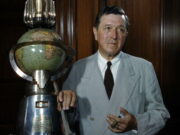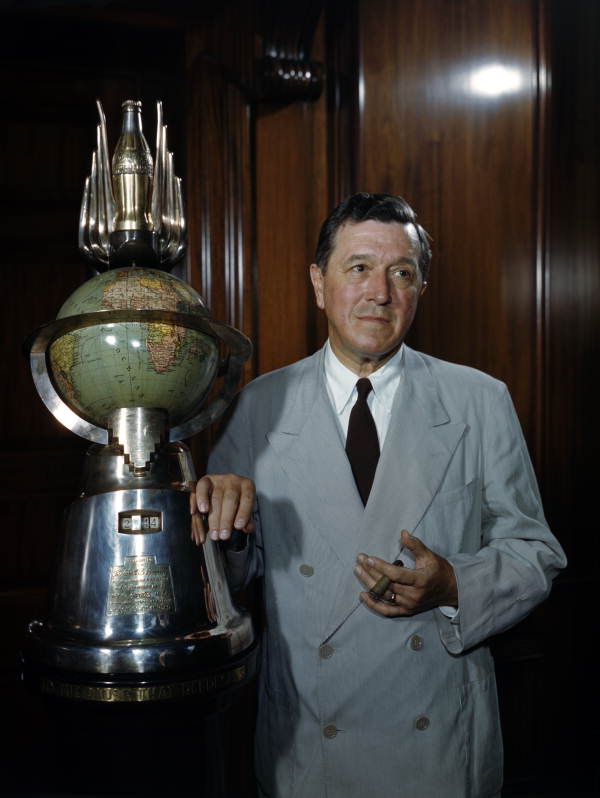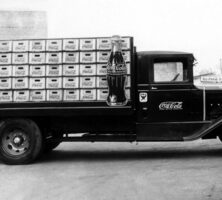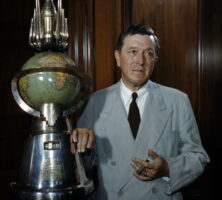The name Robert Woodruff is synonymous with the Coca-Cola Company. His leadership, which lasted five decades, moved the company, in financial straits when he took control, into the ranks of a world-renowned corporation and made Coca-Cola one of the best-known and most widely distributed products.
Woodruff’s impact extended beyond the company he led. He practiced a lifetime of civic-minded philanthropy, most of it anonymously, and exerted a powerful influence on Atlanta’s business, cultural, and political development in the twentieth century. He left much of his personal wealth to a charitable foundation that today bears his name.
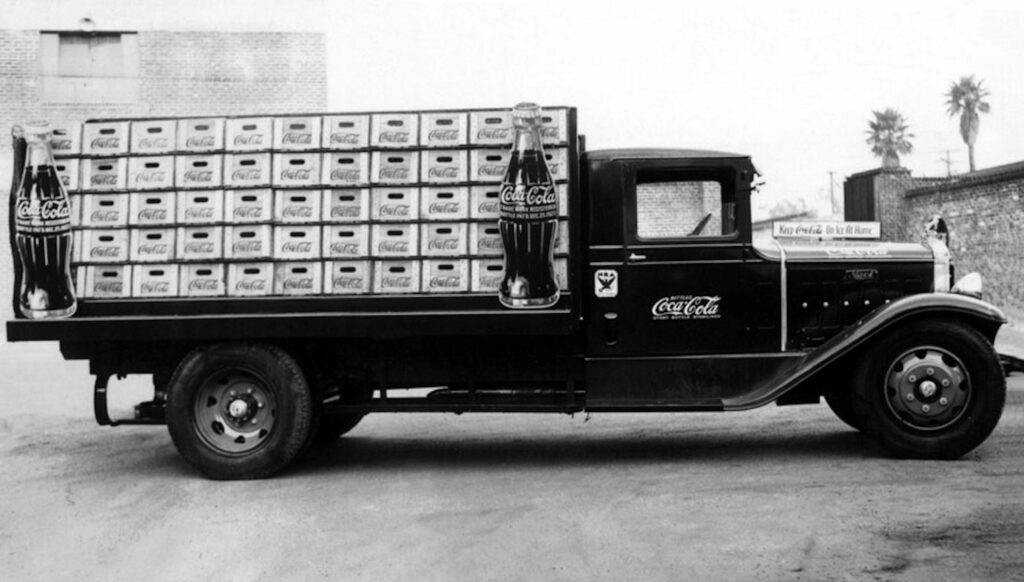
Early Life
Robert Winship Woodruff was born on December 6, 1889, in Columbus to Emily Winship and Ernest Woodruff. He was the first of four sons. Woodruff’s father was a flour salesman for the family business in Columbus. In 1893 the family relocated to Atlanta, where Woodruff’s father worked for Joel Hurt as vice president and general manager of the Atlanta Consolidated Street Railway Company (later Georgia Power Company). A tough-minded businessman with negotiating skills and an eye for corporate development, Ernest Woodruff by 1904 was president of the Trust Company of Georgia, the predecessor of SunTrust Banks (now Truist).
In Atlanta Robert Woodruff enrolled in Atlanta Boys High School (later Grady High School), about two miles from the family’s home on Edgewood Avenue and Waverly Way. He later attended Georgia Military Academy in College Park and after graduation entered Emory College (later Oxford College of Emory University). From an early age Woodruff showed an enthusiasm for sports and the outdoors, and was possessed of a competitive and independent spirit.
Not happy in a classroom, Woodruff set out on his own in 1909 and worked for the next few years at odd jobs in Atlanta. In 1912 he married Nell Hodgson of Athens, and that same year he took a position with his father’s concern, the Atlantic Ice and Coal Company. During a business trip to New York he caught the attention of Walter White, the president of the Cleveland, Ohio–based White Motor Company, who offered him a sales position. While with White’s company, Woodruff traveled frequently from his Atlanta home to New York, Cleveland, and around the Southeast. His astounding sales record earned him a vice presidency in 1921 and election to White’s board a year later.
Coca-Cola Empire
The Coca-Cola Company’s initial fortunes were less impressive. In 1919 a consortium of businessmen, headed by Woodruff’s father and including Woodruff’s friend W. C. Bradley, purchased Coca-Cola for $25 million. Soon thereafter, the company’s stock value and sales of syrup plunged, in part due to market fluctuations in sugar’s price after World War I (1917-18). A “frail bark struggling upon a tempestuous sea” was how the company’s attorney described the business. Vigorous leadership was urgently needed, and with the evidence of Woodruff’s meteoric rise before the board, chairman Bradley offered him the job of president in 1923. Woodruff accepted it, though his starting salary of $36,000 represented a $50,000 pay cut. He was thirty-three years old.
It was a superb match, for Woodruff brought to the company what it needed: an intuitive feel for how to attain success, the instincts of a born salesman, a sharp eye to customer wants, and a principles-centered approach to business as well as to his personal life. As was perhaps most evident to those who knew him, Woodruff disliked losing: the success of the company he led became his passion. These qualities would transform the Coca-Cola Company into one of the world’s best-known and most-recognized brand names.
The soda fountain business prior to 1920 was the main source of company sales, but the rapid expansion of bottling interests fueled Coca-Cola syrup sales through the 1920s and 1930s. Under Woodruff’s directive to establish an international market, bottling plants, to which the company sold concentrate, were operating in forty-four countries by the late 1930s. A deft Coca-Cola Company marketing strategy created a wholesome and satisfying image that made the product a household name, while the distinctive “hobbleskirt” bottle and Coca-Cola script set the company apart from its many imitators.
The well-known existence of a “secret formula” combined with “the real thing” appeal added a unique luster to the soft drink. The company’s marketing savvy was revealed again in the 1930s with the introduction of the innovative red-and-white “six-bottle carton,” which appealed to shoppers in new grocery stores. Despite the downturn in the economy of the Great Depression, the meager five-cent charge for a bottle of Coke kept profits growing and stock value rising.
The onset of World War II (1941-45) led to the rationing of sugar, a major ingredient in Coca-Cola syrup. Woodruff hit upon a brilliant alternative, one that served the country while expanding the Coca-Cola Company’s international reach. He guaranteed the price of a Coke at five cents per drink for all American service personnel, wherever they were located. It was a promise he could deliver on, since war-related production exempted the company from the sugar ration. With the Defense Department’s approval and the endorsement of General Dwight Eisenhower, the supreme allied commander, dozens of new “war” plants were set up abroad to provide a steady supply of bottled Cokes for soldiers in China, Europe, North Africa, and the Pacific. Overnight Coca-Cola became a symbol of home-front support for American troops.
In the postwar years the company built upon its international plants to expand its operations. By 1968, 50 percent of Coke’s net profits came from foreign operations. Woodruff’s vision that Coke be within “arm’s reach of desire” indeed made a spectacular global leap.
Retirement
In 1955 Woodruff turned sixty-five. Company rules required him to step down, though he retained his offices in Coke’s corporate headquarters, a seat on the board, and chairmanship of its finance committee. He continued, in effect, as the company’s unofficial leader until his death.
He also divided his time among favored pursuits. He and his wife valued their time at Ichauway Plantation in southwest Georgia, which they had acquired in the late 1920s. It was a home away from the city where they rested and entertained friends, and where Woodruff indulged his lifelong passion for quail hunting, bird dogs, and horses. He continued quietly to advise Atlanta’s civic leaders, as he always had done, and was especially valuable to mayors William B. Hartsfield and Ivan Allen Jr. during Atlanta’s critical desegregation years—perhaps his least-known and farthest-reaching civic contribution. Sought after because of his superb business judgment, he served on the boards of the Trust Company of Georgia, Southern Railway, and Rich’s Department Store, and also exercised a highly regarded national influence as a director of General Electric, American Express, and Metropolitan Life.
Philanthropy
If Woodruff attained great wealth in his lifetime, he also thought carefully about how that wealth was dispensed. On the surface he was often gruff, awkward in public speaking, and at times withdrawn. But he possessed a personal magnetism and dominance that all who knew him commented upon. In reality, the outward bearing belied warm-heartedness that expressed itself through a lifetime of extraordinary charity. He gave informally to individuals in need, and through his Trebor Foundation (renamed the Robert W. Woodruff Foundation after his death), created in 1937, he gave to charities and organizations both in Georgia and outside the state. He shunned public appearances, awards, and honorary degrees. He gave credit for Coke’s success to others and insisted that his name not be mentioned in his gifts, preferring instead to be known as “anonymous donor.”
A gift of $105 million made by Woodruff and his brother George to Emory University in 1979 was at the time the largest donation ever made to a single educational institution. One of his anonymous gifts helped create the Woodruff Arts Center in the wake of the 1962 Orly air crash, which killed several Atlanta arts community leaders, while other contributions aided community development, historically Black colleges and universities, and the nonprofit sector. His generosity also helped to build Atlanta as a significant medical, health care, and public health center in the South and the nation.
The Woodruffs had no children. His wife, Nell, died in 1968, and Woodruff died on March 7, 1985. The Robert W. Woodruff Foundation received funds from their estates and continues Woodruff’s legacy of philanthropy in the state of Georgia.


